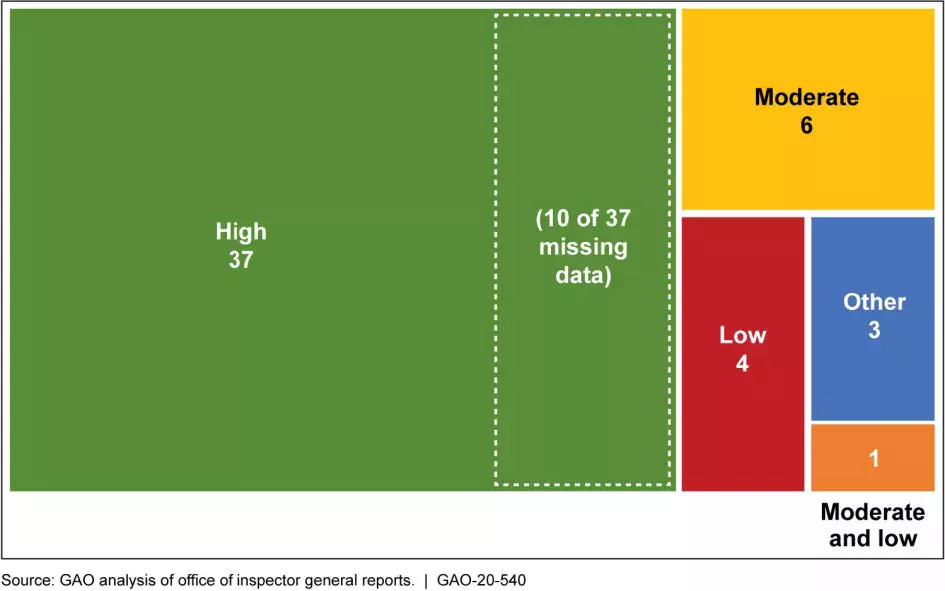USAspending.gov Contains a Treasure Trove of Information, But How Reliable Is It?
August 14 is the deadline for agencies, including those that led the federal response to the COVID-19 pandemic, to certify their spending data made available on USAspending.gov.
Federal agencies are required to report spending information under the DATA Act, and agency offices of inspectors general (OIG) are required to review and report on the quality of agency data. In FY 2019, USAspending.gov reported that the government spent about $4.45 trillion.
Today’s WatchBlog explores our review of 51 OIG reports that expressed concerns about the quality of the data that agencies reported for the first quarter of FY2019. Given that agencies are now required to report how they’re spending their COVID-19 funds on USAspending.gov, the reliability of this data is even more important.
Quality of data
The OIGs’ assessments of the quality of the data submitted varied, with most agencies’ data assessed as “high” quality—meaning error rates up to 20%. However, as shown in the figure below, 10 of 37 agencies with “high” quality data did not submit all the data that they should have.
Quality of Data Submitted under the Digital Accountability and Transparency Act of 2014, as Reported by Agencies’ Offices of Inspector General (First Quarter, FY 2019)
OIGs determined quality based on their assessments of how complete, timely, and accurate the data was (see figure below). Although most agencies submitted data to USAspending.gov on time, some information was missing and some was inaccurate according to the OIGs. Missing data was not assessed by the OIGs, and therefore was not considered in determining the quality level.
Error Rates of Data Submitted under the Digital Accountability and Transparency Act of 2014 as Reported by Agencies’ Offices of Inspector General, by Range and Type of Error (First Quarter, FY 2019)
Missing and inaccurate data
Fourteen OIGs reported that their agencies’ submissions were missing data. For example, one OIG reported that its agency’s submission did not include almost $10 billion of award data. OIGs also reported that certain data reported on USAspending.gov did not agree with agency records. Other inaccuracies were due to agencies having difficulty interpreting definitions or following reporting standards correctly. External systems that incorporate recipient data also caused errors.
Other data limitations
We also reported in November 2019 on some important limitations that are not fully transparent on USAspending.gov. For example, Department of Defense procurement data isn’t shown on the website until 90 days after the agency reports it because of security concerns. Also, information about optional data and unreported data is not clearly explained on the website. These are important limitations of the data that users of USAspending.gov need to keep in mind as they search for COVID19-related and other federal spending.
Improvements needed
While we’ve seen improvements, for example, in the number of agencies that are meeting the timeframes set for reporting, there is still a ways to go. In some cases, errors occurred because agency systems still aren’t fully integrated, and not all of their systems can report the required information. Forty-four OIGs recommended ways to address these and other issues affecting the quality of the data.
For more information about our review, check out our full report.
Comments on GAO’s WatchBlog? Contact blog@gao.gov.
GAO Contacts
Related Products

GAO's mission is to provide Congress with fact-based, nonpartisan information that can help improve federal government performance and ensure accountability for the benefit of the American people. GAO launched its WatchBlog in January, 2014, as part of its continuing effort to reach its audiences—Congress and the American people—where they are currently looking for information.
The blog format allows GAO to provide a little more context about its work than it can offer on its other social media platforms. Posts will tie GAO work to current events and the news; show how GAO’s work is affecting agencies or legislation; highlight reports, testimonies, and issue areas where GAO does work; and provide information about GAO itself, among other things.
Please send any feedback on GAO's WatchBlog to blog@gao.gov.







